Turquoise Energy News #209
Covering
Research & Development Activities & Projects of
October 2025
(Posted November 14th 2025)
Lawnhill BC Canada - by Craig Carmichael
[Subscribe: email to
CraigXC at Post dot com ; request subscription]
Main URL TurquoiseEnergy.com Also at craigcarmichael.substack.com
Month
In "Brief" (Project Summaries etc.)
* Zinc Battery Update: Organic Materials Plus Sides - Ni-MH
Cordless Drill
In Passing
(Miscellaneous topics, editorial comments & opinionated rants)
* Scattered Thots
- Detailed
Project Reports -
Electric Transport - Electric Hubcap Motor
Systems - "not much" (batteries) report
Other "Green" &
Electric Equipment Projects
* Open Loop Air Heat Pumping (not much progress)
* 36 Volt Electric Heater - Take 2 - 3
* Faraday Cabin Construction - Cutting more styrene foam
insulation
* Haida Gwaii Gardening - Winter prep -
Self Pickled Cherry Tomatos
Electricity
Generation
* New Grid Tied System
* Old System - The usual Latest Daily/Monthly Solar Production
log et cetera - Monthly/Annual Summaries, Estimates, Notes
October in Brief
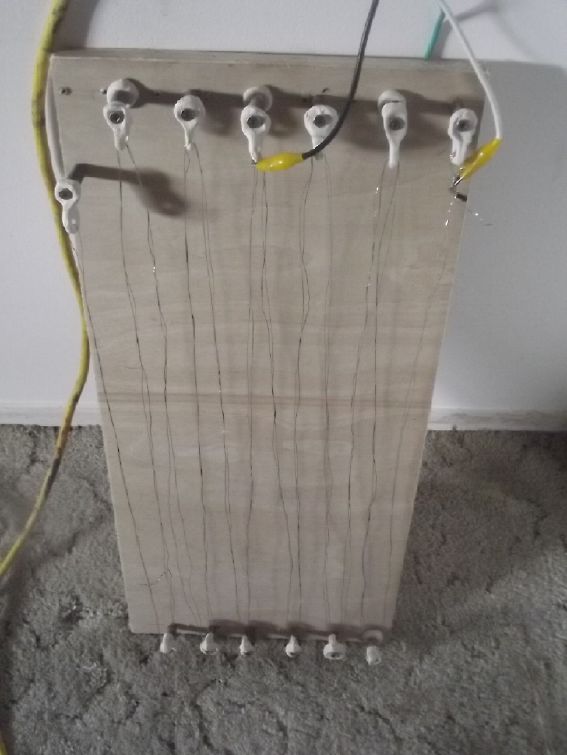 I tried a couple of things with the 36
volt heater I made a few months ago
I tried a couple of things with the 36
volt heater I made a few months ago
I seem to have written a report that's mostly "comments
from the peanut gallery" on topics other than renewable energy
projects. Indeed, lately I seem to be getting "not a lot" done on
anything some months. This month my excuse is I wasn't well for a
week. (Wait... doesn't that leave 3 other weeks?)
October 29th was my mother's 100th birthday. Wow! A lot
has changed since 1925. [Dorothy Irene Wardlaw / Dorothy Carmichael]
At the end of October and into November suddenly
nothing seemed so important as finishing the east part of the
Faraday cabin up at the rafters and removing the scaffolding that
had been there since June, mostly with no work being done. I had had
enough of shinnying up the stairs sideways to get by it! I had it
down and finished on the 9th and finally started editing this report
on the 10th.
Then I decided to try to set up the "Orange PI zero 3"
single board computer in the faraday cabin with 36 volts DC power so
I could work there - a place with much lower electrosmog. It took
all day and still needed an AC power cord because the USB-C cable I
cut apart to power it from the DC to DC converter... well, I think I
goofed. Somehow the little 16" USB powered video monitor seems to
have withstood 36 volts supply instead of 5. "Input out of range -
shutting off." it said. How did it even survive and not go up in
smoke? I'm grateful that it did! But it liked 4.88V even less and
kept resetting itself (and sometimes the computer, depending on
cables) as the video came on. I finally figured out that was the
problem by turning it above 5.0V late on the 12th. (Probably I could
have powered it from the USB hub all along, as originally planned!)
I also found that if I stuck the WiFi antenna outside the alume vent
screen & metal cabin wall, and put a hub with WiFi at the far
end of the house, I could get internet. ("2 bars") That's my excuse
for the late newsletter.
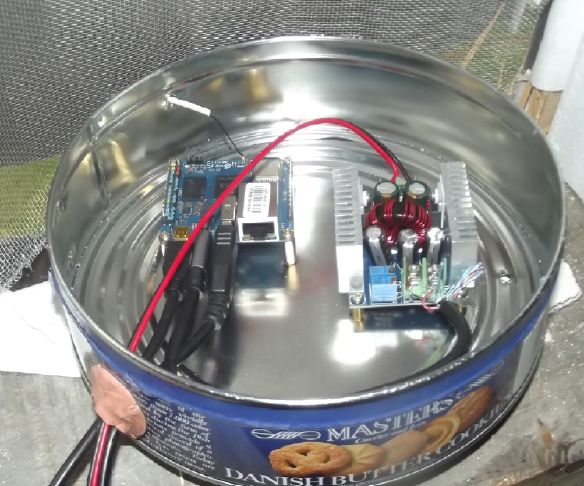 I mounted the single board computer and
the DC to DC power
I mounted the single board computer and
the DC to DC power
adapter in a metal cookie tin. The wifi wire sticks out at the
back.
At the front: computer's single USB to 7-socket USB hub, HDMI
video
to monitor, separate power cable to video monitor, 36VDC power
cable.
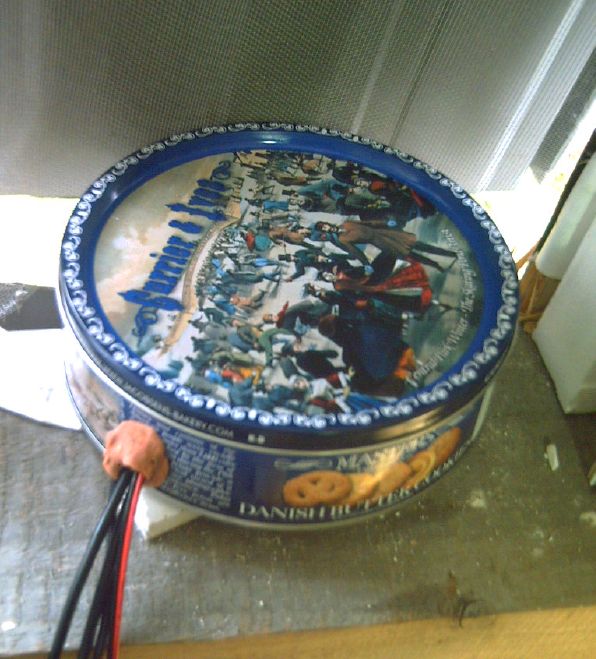
With the grounded metal cover, most of the electrosmog
should stay inside.
(But I should keep the WiFi off except when I want to go on
line.)
Zinc Battery Update: Organic
Materials Plus Sides
I worked for 16 years to create a zinc battery
(Ni-Zn, Cu-Zn...) that should last "forever". I had the zinc side
working, long a "holy grail" of battery making. It seemed to me
there were several choices for the "+" side.
Now Sam Evans, "Electric Viking" on youtube, brought
a video where Singaporean and Chinese researchers have done as
well or better with a "3D Organic Polymer"-Zinc Ion battery. They
say they have solved issues that have plagued aqueous zinc-organic
batteries. It basicly has the very features I've been espousing
for my cells: almost 'forever' life span, low cost and 192 KWH/Kg
energy by weight. It's about 1.32 volts at full charge with a
mid-charge level of 1.17 volts. Charge efficiency is said to be
"almost perfect". And they're pushing for the same target market:
home energy and "micro-grid" level energy storage... plus,
"wearable" or pocket electronics. The organic positive electrode
can apparently move a record 5 electrons per molecule. (Although,
the molecules look pretty big.)
Evans thought, and of course I could only agree, that
this battery report was more important than 95% of the battery
research reports he has presented.
12 Million Miles - The New Battery Tech That Could Power an EV
for 100 years
https://www.youtube.com/watch?v=28tD_TAAPDU
(Note: Most of the video image clips are irrelevant to the content
discussed. It's just visual filler. Sam mostly read from the
company's info page, which I found later.)
In more recent years I had been sticking with
graphite and metal oxides for the positive sides - anything that
would let zinc unleash its potential! At least nickel,
nickel-manganese and copper hydroxides seemed workable. It may
well be that the organic polymer is a better idea. I've never
considered it, as such... (or have I?) Apparently it's been around
in recent zinc battery research, but this seems to be the first
successful mix of polymers, one that gives the current collector a
conductive "3D" geometry. Apparently their cells are acidic with
mobile Zn++ ions. I started wondering if a similar polymer, or the
same, might be used with alkaline cells?
Wait... what was that stuff I was doing when I first
started the project in 2008, when I felt I was being led to do
certain things but before I really started understanding what I
was doing? That was doing some strange synthesis things with
organic ingredients. Going back, from TE News #1... ya, I really
was pretty clueless. Even the right ingredients and techniques,
mixed up "randomly", are not going to make a battery. But I was
learning!
In the box of oldest battery project stuff, I found a
plastic honey pot of the baked bean/monel/lanthanum substance
first mentioned in TE News #6, with a post-it note on top saying
what it was. The lid had disintegrated into several pieces but
luckily the post-it had stayed and kept most dust out and the tub
was still whole and hadn't leaked out the contents. If it was to
work, surely it would have to conduct electricity. I got out the
multimeter. By gosh, it did! It was megohms, but it was just baked
clumps, not even compacted. Compacting should reduce the
resistance by orders of magnitude. Frying beans with monel and
lanthanum hydroxide until it catches fire just isn't the same
thing as "sintering", which was my original understanding of the
objective from reading previous battery research. Once I knew more
about electrochemistry and other battery research, making such a
thing as this powder - and expecting it to be conductive - would
have seemed ridiculous and I probably wouldn't have done it!
Instead I followed the inner guidance that was proffered. It then
remained for me to start understanding what I had done. Instead I
eventually forgot about it.
Perhaps it chelates the metal ions into the organic
mix, the thiamine mononitrate base? I poured the clumps and
powder, suddenly of interest again, into a PETE jar. (Quick while
the old container is still in one piece!) Of course all this is
different than the polymer for a "zinc ion battery" [Zn++] in
acidic electrolyte, which seems right since I've been doing
"mildly alkaline" chemistry with non-migrating "zincate" ions
[Zn(OH)4-] all along. Zinc's voltage is higher in alkaline
solution than in acid (-1.24V vs. -0.8V), although the overall
cell voltage also depends on the plus side. Recently when
everything went well I was getting around 1.3 V with Cu-Zn fully
charged, dropping to maybe 1.1 or 1.0 V when it was largely
discharged.
Maybe time for some more experiments this
winter?
Ni-MH Cordless Drill
I have about four cordless drills that take Ni-Cd or
Ni-MH batteries. Ni-MH batteries ran the drills over twice as long
as Ni-Cd on a job, and lasted about ten years. They eventually
lost capacity, and I can't seem to order more sub-C cells, once
the "universal" cordless power tool size. (I tried once. The store
sent some ancient stock that held no charge whatsoever - utterly
ruined from sitting on a shelf for years without ever being
recharged.) Good Ni-MH sub-C cells ran the drills longer than the
basic (18650?) lithium cells in newer drills. With the 18 volt
one, Tom screwing together a metal roof said he'd never used a
drill that would just run all day without a recharge before.
I asked myself why I kept them, having long since
bought one new one with a lithium battery and being unable to
replace their batteries. But it would be nice to have a spare
drill or two. Then I thought to do what I had done on the very
first drill I had when the Ni-Cd's went bad: remake the battery
pack with 8 Ni-MH AA cells. They aren't made for such high drain
as a power tool, and they are only 2/3 the amp-hours of "sub-C"
cells.
 At first I thought to use up my oldest AA cells, but it hardly
worked. I connected two 0.27 ohm resistors (0.56 ohms) to
alligator clip leeds and clipped them to my voltmeter probes. With
this 2 amp load these old cells (which are ten or more years old)
dropped to .2, .4 or .6 volts. They still run a clock or a
flashlight okay, but not the drill. Newer cells stayed above 1.1
volts. Having gone this far, I replaced the cells in the pack with
the better ones.
At first I thought to use up my oldest AA cells, but it hardly
worked. I connected two 0.27 ohm resistors (0.56 ohms) to
alligator clip leeds and clipped them to my voltmeter probes. With
this 2 amp load these old cells (which are ten or more years old)
dropped to .2, .4 or .6 volts. They still run a clock or a
flashlight okay, but not the drill. Newer cells stayed above 1.1
volts. Having gone this far, I replaced the cells in the pack with
the better ones.
I used an old Ni-Cd sub-C cell as a spacer to push
the contacts up into the "neck" to connect with the drill.
 It starts up sluggishly and one would think it would have no
torque to speak of, but it worked fine when I went to do some
construction with it, drilling pilot holes and putting in 1.5 inch
screws, and it worked as long as I needed it for. It just screwed
slower when it got tough. (It probably would have stalled on 3
inch screws into lumber.) I first used it "for real" when the
Li-ion drill (too frequently) died during the job in the cabin, so
I didn't immediately have to run back to the house and change
batteries.
It starts up sluggishly and one would think it would have no
torque to speak of, but it worked fine when I went to do some
construction with it, drilling pilot holes and putting in 1.5 inch
screws, and it worked as long as I needed it for. It just screwed
slower when it got tough. (It probably would have stalled on 3
inch screws into lumber.) I first used it "for real" when the
Li-ion drill (too frequently) died during the job in the cabin, so
I didn't immediately have to run back to the house and change
batteries.
This was a 9.6 volt drill with 8 cells. Later to beef
it up a bit I added a ninth AA cell, bringing it to a nominal 10.8
volts. It didn't blow up, and had just a bit more pep. I charge it
with a lab power supply set to 1.40 * 9 = 12.6 volts. One of the
things that kept killing both Ni-Cd and Ni-MH power tools was the
patheticly cheapskate battery chargers the companies supplied with
the drills. They went up to stupid voltages, like maybe 1.5+ volts
per cell, and typicly they never shut off -- they just kept frying
the dry cells forever, heating them up until the little water in
them gradually vented out. They were built to fail prematurely!
Lithium cells wouldn't last very long with such treatment, either.
In fact I think the only thing that finally induced companies to
supply good chargers that shut off when done was that lithium
cells can readily catch fire or explode if charged too hard, and
they didn't want to be sued for people's burned down houses and
deaths by fire. Apparently that's a much stronger incentive than
doing it right just because it's right and will provide a product
that lasts much longer!
Anyway, now I have two working cordless drills so I
can drill pilot holes and then put in screws without swapping bits
back and forth. Possibly I may do one of the 18 volt ones (15
Ni-MH dry cells) some time, which should have more pep.
In
Passing
(Miscellaneous topics, editorial comments & opinionated rants)
Scattered Thots
* Here's something I think is significant for Earth's future. But
what is a "conservative" versus a "progressive"? To stereotype in
the present US context, "progressives" seem to be the antagonistic
ones, always "fighting against" something... "social justice
warriors". They don't get along well with people whose views are
different than theirs. Women as well as men put career ahead of
having families. "Conservatives" are those more in tune with
family values, traditions and institutions fostering societal
cohesion and continuity.
Families used to come unbidden, wanted or not.
"Everybody" had families, usually large. Since the beginning of
birth control pills and other effective contraceptives in the
1960s, more and more those who don't want families don't have
them, and the size of families has become smaller. And with ever
worsening economic conditions, the many who aren't sure of their
long term ability to provide for a family don't have one either.
They put it off and put it off, hoping for better times. Now, here
it is in statistics!

Economics will sometime improve as the population
shrinks, as it inevitably will owing to the low birthrates of
recent decades even if there are no calamities that accelerate the
process. It looks to me like many of the people who will improve
the races (all races) are having families, while many of those who
won't are unselecting themselves for the next generation(s). This
seems to bode well for the future of the planet.
"The meek [even tempered, balanced] shall inherit the Earth." -
Jesus
---
* From the same article on Zerohedge.com (I didn't note the link
or title) It seems polluting and CO2 emissions are
dropping pretty fast -- hurray! One could argue that it's "net
zero policies" driving the reduction. OTOH, one could argue that
it's LED light bulbs, electric cars, solar power, and so on, and
that the politicians are in a silly panic to force something
already happening to happen a little faster. (...and then
perchance, to take credit for it?) Solar power is a major portion
of new energy production, and it's totally scaleable.
For an example of results of authoritarian political
actions I think of light bulbs. Politicians made 100 watt and
above incandescent bulbs illegal in some jurisdictions just at the
time LED bulbs came out using maybe 15% as much power, and people
were stopping buying incandescent bulbs anyway. That was about
2012. Shall we attribute the reductions following that time
(visible especially in the France graph) to the politicians? LED
lighting surely played a much bigger role than banning 100+ watt
bulbs!
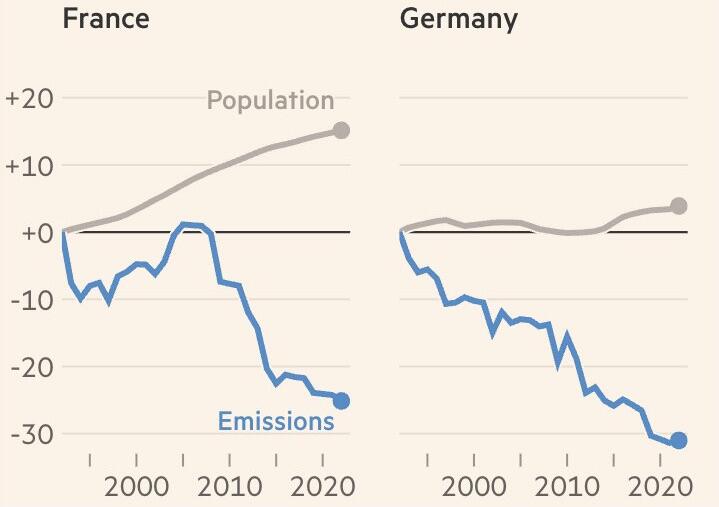
* Banning higher wattage incandescent bulbs also reveals the
ignorance of present day politicians, generally none of whom know
anything much technical. A 100 watt bulb typicly has about the
same lumens as two 60 watt bulbs while using 20% less electricity,
and a less "orange" color. Likewise, a 200 watt bulb is typicly
well over twice as bright as a 100 with a still whiter spectrum.
(The manufacturers intentionally designed them that way many
decades ago and apparently never re-thought them as electric rates
rose and prices for bulbs dropped.) So (assuming LED bulbs weren't
already arriving at that time) banning larger wattage bulbs could
sometimes force people to put in more light fixtures and burn more
electricity to attain the desired or required amount of light.
Seemingly, in our huge legislatures of hundreds of people, no one
knew to speak out and help make a better informed decision on the
matter, and no consideration was given for possible unintended
consequences.
I refer the reader back to Unrepresented
Constituencies [TE News #201] where we would elect our
representatives based on our own occupational field and
philosophic interests rather than "by area" to represent everyone
in general and no one in particular. Then we would have
legislatures with elected people knowledgeable in many fields.
* Potentially we might also have a "predictions" department
associated with each legislature, which would examine and forecast
the likely consequences of pending legislation - good and bad,
intended and unintended - before it was voted on, and report to
the legislature before it took a decision. (There's a youtube
channel about "unintended consequences". ["...with the best of
intentions -- What could possibly go wrong?"])
---
* A question that must occur to many of us once in a while...
There are a few videos on the subject. This seems like a good one.
"If Every Country Is in Debt… Who’s the Creditor?" -
Financial Historian
- https://www.youtube.com/watch?v=Q3UI39q-M0Q
---
* Against which minority group is there the most prejudice?:
- Blacks ("albedo challenged" peoples?)
- Jews
- Muslims
- Whites
- Russia and anyone who speaks Russian
---
* One day I heard that a fellow inmate, his cell mate, had taken a
broom handle and stabbed Robert Pickton with it, killing him. On
top of the 50 or so bodies of young women unearthed at Pickton's
pig farm what was it...? 30 ? years ago, Pickton had murdered
another inmate in jail, and boasted he was going to do it again.
The man who killed him said he had done it on behalf of everyone.
He will probably be further punished for the murder, but in truth
he had finally done what Canadian society should have done, but
was too gutless to do, 30 years ago. Instead we have all been
paying for Pickton's food and warehousing all this time - for
someone we would never want loose on our streets again no matter
what. The 50 women and the inmate he killed are all still dead.
But now he'll claim no more victims. A long belated Good Riddance
to Robert Pickton! Whether he chooses eternal life or oblivion
when confronted with the universe repercussions of his life, is
not our responsibility. Nor can we help any of the many victims
who he so early deprived of their Earth lives.
---
* It's recently been claimed that Nicolas Maduro of Venezuela has
been sending money to "domestic terrorist" groups in the USA to
try to help destabilize the country. Despicable! - using the USA's
own destabilization and "regime change" tactics against the USA!
The USA has been using such weapons for decades
against Venezuela -- economic sanctions, funding and arming
violent opposition groups, an attempted coup, refusing to sell
them parts to keep their oil industry running, and blocking their
exports at sea. They claim Maduro is a drug-running dictator who
has to go. It sounds likely that Venezuelan elections are rigged.
But that's a feeble excuse - Washington has no problem supporting
dictators it likes. In fact it prefers them to democracies where
someone they don't like may be elected any time.
Venezuela presently has the most oil reserves of any
nation. It has been said that Maduro has written to Trump offering
some generous terms for Venezuelan oil with American corporate
participation, but evidently they weren't generous enough to open
a bargaining discussion.
Americans blame Venezuela's "socialism", but
Washington's measures have obviously contributed heavily to
Venezuela's economic collapse and ruin and the poverty, misery and
death of the Venezuelan people. Perhaps drugs are the export of
last resort? But so far the sanctions have failed to bring about
change of government. Now they flirt with direct invasion with
mighty warships off the Venezuelan coast and military aircraft
stationed in Puerto Rico.
What's it really about? They speak of drugs coming
from Venezuela to the USA by boat. (It would appear to be true.
What fisherman puts dual 100+ HP outboards on the back of a boat
obviously designed for speed and goes fishing far offshore?) But
being only in the early stages of switching to solar energy - and
dragging their feet - the USA needs major new sources of oil for
its economy, and it doesn't want to pay anything like fair market
value for it.
Just my take.
---
* Meanwhile, politicians in the crumbling European Union continue
to agitate for war against Russia (4th largest oil reserves &
lots of natural gas), to be blamed (of course) on Russia. This to
hide their own failures to maintain prosperity in their domains.
If the EU can actually mobilize enough of their "fed up"
populations to start a war, seeing what's happening in Ukraine now
(even with powerful US and EU support), Europe would surely be
soundly trounced.
Russia would stop the present war, which began as a
civil war of secession following the US led Ukrainian coup of
2014. The elected government was routed "to uphold democracy"
because the USA didn't like its direction. Russia won't give up
the territories they have conquered or assisted the Donbass
peoples in holding or liberating, which are mostly populated with
Russian peoples who voted overwhelmingly to join Russia when given
a chance to vote in 2022 (or 2023?). It would now be a betrayal
for Russia to vacate and leave them to the mercies of the
Ukrainian neo-nazis who had been persecuting them since 2014. But
Ukraine, or at least Zelensky, refuses to end the war until all
these same hated Russian peoples are returned to its jurisdiction.
(even Crimea where there are practicly no Ukrainians.) In this
circumstance the war will continue until Ukrainian leadership
changes its mind or is defeated. or by some bizarre happenstance
Russia is defeated.
Russia likewise has no intention of invading "woke"
Europe, now so flooded with often violent immigrants... unless
Europe (not for the first time) makes itself into an implacable
foe like Ukraine. Ukraine had all the immense territories allotted
to it over the years by the tsars and the communists until the
2014 coup (far more territory than the real "Ukraine"). Everything
it has lost since then it has lost by refusal to be reasonable, by
blind hatred and prejudice. The slow progress of this "modern" war
wasn't foreseen, but continuing Ukrainian losses were foreseeable,
and none of it was necessary.
The EU was doing quite well until 2022 when it went
along with American sanctions "against Russia". It has poured its
economic life blood into supporting Ukraine to its own detriment.
(In fact, in most every decision and policy, EU leadership seems
"hell bent" on destroying European civilization.) The war has
built Russia into the world's premiere armed power, with its
factories churning out war materials in bulk. Why would Europe
want to put itself in Ukraine's position of starting a war that
most people don't want, and that similarly can surely only bring
loss after loss - lives, land, infrastructure - for as long as
they care to continue waging it?
* Again, why can't every oblast (province/state) decide by voting
with what national entity it would like to associate - or form? Of
what sense is war? To be fair this could include oblasts bordering
around Ukraine in Belarus, Russia, Hungary, Romania, Moldova and
Poland, a few of which were shuffled arbitrarily about in the
Soviet era. "Novorussia" (DPR, LPR, Zaporojjia, Harkov...) might
elect to form a new state rather than be part of Russia (or
Ukraine) if offered the choice and not threatened with Ukrainian
invasion.
* "Happy are the peacemakers, for they shall be called the Sons of
God." They seem to be in short supply in Ukrainian and European
leadership right now.
---
* I recently heard that eating cocoa causes the bone marrow to
release stem cells into the bloodstream. Some of them may drift
around to somewhere where they may lodge, differentiate into a
needed cell, and help repair some cellular damage. Eating that
dark chocolate is then a stem cell medical treatment, something
much sought after by medical researchers! Perhaps we should have
guessed that we crave chocolate for an actual, valid reason!
...Now, what about licorice? Well, time to pour myself another
coffee.
ESD
(Eccentric Silliness Department)
* Blessed are the pacemakers, for they shall strengthen the faint
of heart.
* Defence: to remove a fence. | | | | | | | | | | | | | |
| | | | | | Defense: to erect a fence.
* The donker donked the donkee. The donkee brayed loudly in
annoyance at being the object of such an absurd "pun".
* Florest: A land of giant flowers. (There are no
woodpeckers there, but the size of some of the caterpillars has to
be believed to be seen!)
"in
depth reports" for each project are below. I hope they may be
useful to anyone who wants to get into a similar project, to glean
ideas for how something might be done, as well as things that
might have been tried, or just thought of and not tried... and
even of how not to do something - why it didn't work or proved
impractical. Sometimes they set out inventive thoughts almost as
they occur - and are the actual organization and elaboration in
writing of those thoughts. They are thus partly a diary and are
not extensively proof-read for literary perfection, consistency,
completeness and elimination of duplications before publication. I
hope they may add to the body of wisdom for other researchers and
developers to help them find more productive paths and avoid
potential pitfalls and dead ends.
Electric
Transport
A "Not Much" Report
After renewing two
lead-acid batteries for the outboard/unipolar/Caik motor tests, I
found a suitable wooden box and decided to get out 8 (24V) of the
new 325 amp-hour lithium - iron phosphate cells instead. I also
spent a day digging out my boat trailer from some old rotting
palettes and tall grass and weeds - even an alder sapling. I
haven't used it in some years. (It was parked beside my shipping
container. In trying to stop condensation I had put the palettes
on the roof and then a plastic tarp over it all. After a couple of
years the tarp ripped to pieces and I had dropped the palettes off
the side, next to the trailer. intending to deal with them later.
not this much later! Being unable to move the trailer or mow the
grass, the palettes were gradually covered. They rotted and the
sapling grew up right by the trailer. Not inside it -- but I've
seen abandoned cars with trees growing up through them!)
The 325 amp-hour cells weighed 11 pounds each. Eight
in one box was about 90 pounds. That would be too much to lift in
and out of the boat. (or at all!) But it seemed I could cut the
box in half and make two new ends, so 45 pounds in each of two 12
volt boxes, at the expense of connecting a fat wire between them
on the boat. I did it. Much more manageable!
(Hmm, I seem to have abandoned the project for the winter. Next
summer?)
Other
"Green" & Electric Equipment Projects
Open Loop Air Heat Pumping (OLAHP)
[28th] Where was I again? Oh ya, last
spring saying this project has too valuable a potential to let it
slip away again. Now here it is the end of October!
First: What was I going to do about having
thoughtlessly drilled an allen wrench access hole in the exact
wrong place - right at the top (seemed logical if one gave it no
thought!) -- right where the wall and the piston meet and the air
gap needs to be zero? This is what has most been bothering me.
Heat glue would probably melt during operation. I thought of
filling it in with little flakes of UHMW. But how to melt them
into place, without distorting the UHMW cylinder itself? Then I
thought of getting a small brass tube and drilling out a solid
UHMW plug of just the right diameter.
As I cut the tube I thought of trying to melt it
through instead of filing "teeth" into the tube and drilling. I
went back with a piece of UHMW, a heat gun, the tube and forceps
to hold the hot tube. I tried for about 30 seconds, then looked
and found I had made only a half circle mark on the surface, just
enough to keep the tube from slipping away as I turned it.
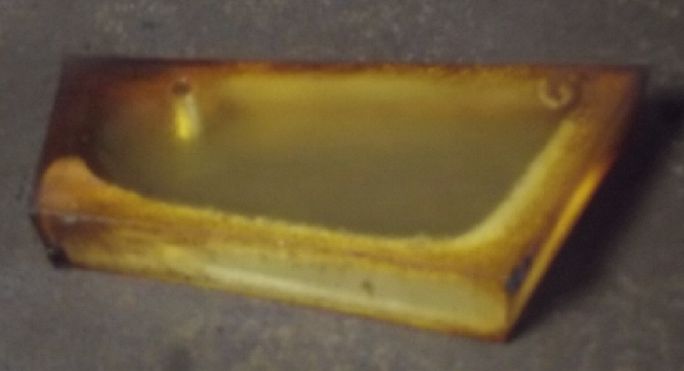 Then I thought of putting the whole
piece of plastic in the kitchen oven. After all, it was still so
stiff in its "melted" state that it didn't even seem to sag. I put
it in the oven on 400 degrees F for 30 minutes. It went from white
to transparent. It was still so stiff I needed assistance to punch
the brass tube through. I used the hydraulic press.
Then I thought of putting the whole
piece of plastic in the kitchen oven. After all, it was still so
stiff in its "melted" state that it didn't even seem to sag. I put
it in the oven on 400 degrees F for 30 minutes. It went from white
to transparent. It was still so stiff I needed assistance to punch
the brass tube through. I used the hydraulic press.
 The piece was pretty ugly and I tried again, but I guess it had
cooled more and although it still went through, there was no piece
inside the tube at all. It had just squished around it.
The piece was pretty ugly and I tried again, but I guess it had
cooled more and although it still went through, there was no piece
inside the tube at all. It had just squished around it.
So I took the first piece and pushed it in. One end
broke off. The rest fit okay. I cut a few bits off the
"mushroomed" end and it fit in.
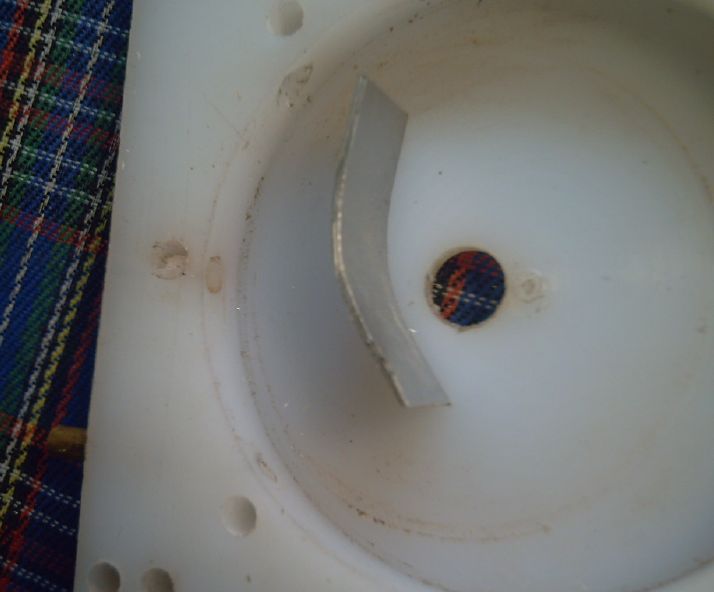 Not quite satisfied with the fit I put in a couple of UHMW flakes
and bent a piece of alume to the general curve, heated it up, and
melted the flakes into the join area. They filled a tiny gap and
it seemed pretty good.
Not quite satisfied with the fit I put in a couple of UHMW flakes
and bent a piece of alume to the general curve, heated it up, and
melted the flakes into the join area. They filled a tiny gap and
it seemed pretty good.
What happened after that? Hopefully I'll get more
done in November!
36
Volt
Electric Heater - Take 2
I had put together a resistance heater from
resistance wire wrapped between screws on a piece of plywood. I
had been using it in my bedroom at night. and or in the day if
there was power to burn and it was cold out. But I always thought
that having screws transferring heat from the wire to the plywood
was a poor idea, and that it would be better with porcelain
insulators and no electrical or heat connections to the screws. I
could attach the alligator clips anywhere for any wattage, but
instead I had simply used all the wire and never got it too hot,
which limited the heater to 250 watts.
 [25th]
I got out some grey clay ["Laguna B-mix, cone 5"] and shaped such
insulators along with some spacer washers, and let them dry.
[25th]
I got out some grey clay ["Laguna B-mix, cone 5"] and shaped such
insulators along with some spacer washers, and let them dry.
[26th] I dried them further on top of the woodstove, then fired
them for three hours in my mini-kiln. That's about "cone 5".
Apparently the tile I set them on was only good for ceramic
firing. It melted into the kiln bricks and to the pieces. To get
it out with a chisel it took chunks out of the kiln floor, which
was specially shaped kiln block. I broke a couple of the
insulators chiselling them off, but I had made a couple extra.
 [27th] I unwrapped the heating wires and assembled
it the new way. At a place where a join was needed, the wires were
two inches to short to reach each other. I moved the end screw
down two inches, gaining four inches of wire so that there was an
overlap instead and I could twist them together.
[27th] I unwrapped the heating wires and assembled
it the new way. At a place where a join was needed, the wires were
two inches to short to reach each other. I moved the end screw
down two inches, gaining four inches of wire so that there was an
overlap instead and I could twist them together.
The result was disappointing. The wires were too
close together and when they got hot and expanded, a couple of
them touched. As the wires were doubled everywhere, I turned it
off and twisted most of them together to strengthen the
arrangement. The alligator clip leeds I had powered it with now
had to be connected straight to the heater wires instead of to the
screws. They got much hotter and one fell off its wire. Solder
would have melted!
Somewhere during the new assembly I realized that
when I had twisted the wires together at the screws in the
original build to keep them a bit farther apart, the current would
pass through the twist instead of going around the screw. The bit
of wire around each screw didn't get hot, and so the screws
weren't as hot as expected! If I gave the wires a couple of twists
to get the heat a little farther away, the screws would hardly get
warm! The porcelain insulators to keep heat from running down the
screws to the plywood would be superfluous!
 Except for being nearly finished at that point, why was I doing
this then? Using the screws would be actually superior as well as
easier to make, eliminating the pottery. Just like I had it in the
first place, with an extra twist at each screw. I took it apart
and put it back together that way. (Hmm... the screws where the
clips connect will still get hot!)
Except for being nearly finished at that point, why was I doing
this then? Using the screws would be actually superior as well as
easier to make, eliminating the pottery. Just like I had it in the
first place, with an extra twist at each screw. I took it apart
and put it back together that way. (Hmm... the screws where the
clips connect will still get hot!)
Tho I do use it, it's still just a basic "cool, it
works!" prototype. My only other innovation was to clamp the
supply cable to the wall at the top of the heater. If the heater,
which I simply lean against the wall in a quiet corner, ever fell
on its face it could start a fire. With the cable clamped, first
the cable would stop the heater from falling, and if it did
anyway, the alligator clips would have to unplug.
All a bit hokey. A production "36 V infrastructure
parts & equipment" heater would want a thorough redesign. I'm
seeing why the heater wires are usually wound into coils. A grill
on the front of the would certainly be an asset. 36 volts is safe
electricly, but the wires, while not hot enough to glow, will
definitely burn if touched. Power switches for ON-OFF and watts
selection would be a must. A thermostat would be handy, as would a
low voltage cutout to ensure it couldn't drain the battery if it's
running off one.
A 500 watt heater running for just 24 hours would
drain 12 KWH, which is bigger than my 10 KWH battery and more than
the solar supplies in a day except on the sunniest of summer days.
(And who needs a heater then?)
"Faraday
Cabin"
Construction
Ceiling
Again I didn't get a whole lot done for most of
October. I cut, painted and installed the ceiling trim boards
along the four foot sides of the paneling. Except one. Seems I had
cut, but didn't paint, any extras, and somehow I trimmed one too
short. That one I can get to after the scaffolding is removed, so
good enough for now.
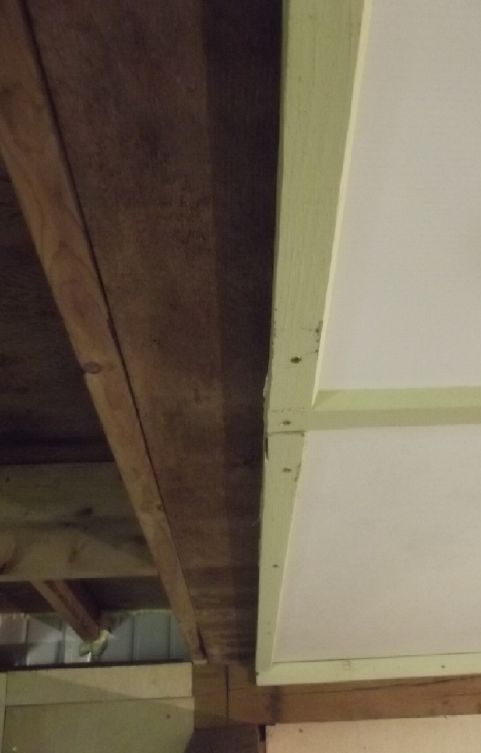 To do a lowered ceiling in the East half when the West half is
vaulted ceiling, I needed to put up a "gable end" wall at the
center. The ceiling panels and the 8 foot (east-west) trim pieces
stuck past the critical point a few inches, and I wasn't sure what
to do. I put up the 4 foot (north-south) end trim about where I
thought it should go anyway, and that made the way clear: I could
cut the ceiling panels along the edge of the trim with a knife,
and then trim the offending E-W trim boards even with all that. I
had ordered an "oscillating multi-tool" from China which would
have been great - and safe - to cut the ends of the boards, but it
hadn't come yet so I used the circular skill saw as carefully as I
could. I don't like holding a saw that can kick right over my head
to do a fine cut, but I couldn't think of anything else that was
practical.
To do a lowered ceiling in the East half when the West half is
vaulted ceiling, I needed to put up a "gable end" wall at the
center. The ceiling panels and the 8 foot (east-west) trim pieces
stuck past the critical point a few inches, and I wasn't sure what
to do. I put up the 4 foot (north-south) end trim about where I
thought it should go anyway, and that made the way clear: I could
cut the ceiling panels along the edge of the trim with a knife,
and then trim the offending E-W trim boards even with all that. I
had ordered an "oscillating multi-tool" from China which would
have been great - and safe - to cut the ends of the boards, but it
hadn't come yet so I used the circular skill saw as carefully as I
could. I don't like holding a saw that can kick right over my head
to do a fine cut, but I couldn't think of anything else that was
practical.
[The multi-tool arrived a week later. "Battery not included" but
it takes the same battery as my "DeWalt" drill, and I expect I
won't be using it very often. It soon came in handy for cutting a
square hole for a light switch (= electrical box) in the 1/4 inch
plywood I'm using for wallboard.]
 After that I started in on framing the triangular space between
the 6 by 6 beams, roof angle and lower support. Then I cut 1/4
inch plywood paneling to fit.
After that I started in on framing the triangular space between
the 6 by 6 beams, roof angle and lower support. Then I cut 1/4
inch plywood paneling to fit.
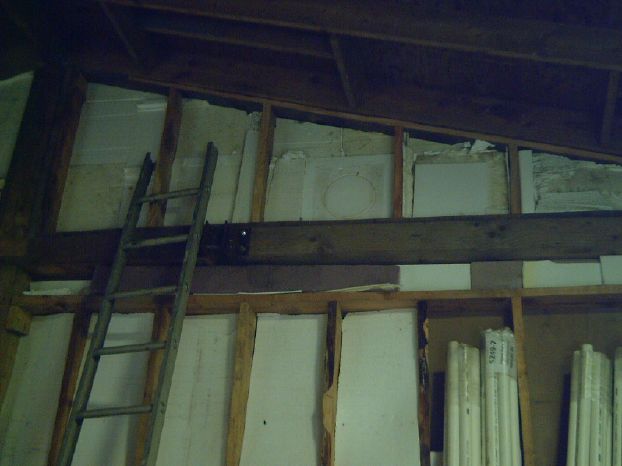 [November
2nd] The interior "gables" needed insulation and I got started on
that, including at the end of the bedroom. With no roof insulation
yet, doing that bit of wall just might make it just a touch easier
to heat the bedroom, too. [Seemed to help.] I also tacked up some
2x8 foam panels between the studs on the other bedroom interior
wall. That too should help until the whole structure is insulated.
(One thickness of 1/2 inch gyproc isn't noted as being wonderful
insulation!)
[November
2nd] The interior "gables" needed insulation and I got started on
that, including at the end of the bedroom. With no roof insulation
yet, doing that bit of wall just might make it just a touch easier
to heat the bedroom, too. [Seemed to help.] I also tacked up some
2x8 foam panels between the studs on the other bedroom interior
wall. That too should help until the whole structure is insulated.
(One thickness of 1/2 inch gyproc isn't noted as being wonderful
insulation!)
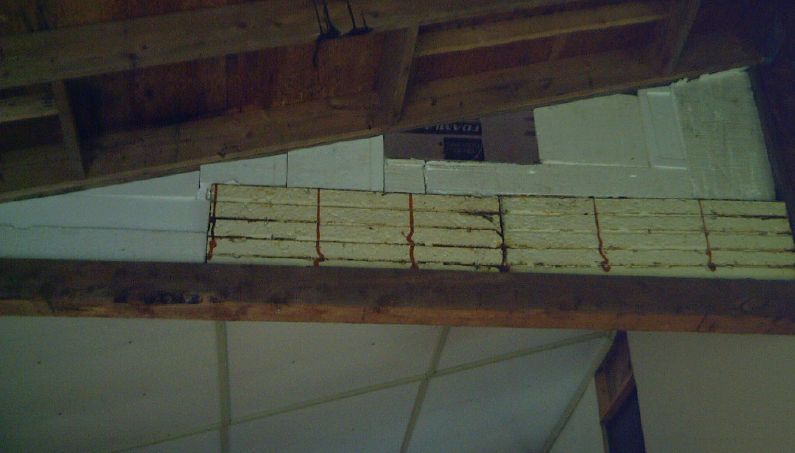 [Nov.
3rd] I did more "gable end insulating" and felt I was ready to put
the plywood up. Again I used scraps of styrene foam (2+ inches
thick - R10+), plus a couple of polyurethane(?) foam pieces from a
freezer (R6 per inch: R12+).
[Nov.
3rd] I did more "gable end insulating" and felt I was ready to put
the plywood up. Again I used scraps of styrene foam (2+ inches
thick - R10+), plus a couple of polyurethane(?) foam pieces from a
freezer (R6 per inch: R12+).
(I neglected to take a picture from the other side before I
put the wallboard up.)
[Nov. 4th] I cut a few more plywood pieces to fit so that I could
paint everything at once. [Nov. 5th] I painted all the pieces of
plywood including the last section of wall above the scaffolding.
Then I painted and put up more wallboard above the
stairs - the last high up part that wasn't finished. Why would I
leave that one part undone? I used a new can of white paint which
wasn't at all a match for the last pail. That's what I get for
shopping at the refuse station and the recycling centre. (They're
glad not to have to ship it off island. Oodles of great free
paint, often full pails!)
Finally on November 9th I took down the scaffolding from the
stairs end and the next day the rest of it. Then the unpainted
places covered by the scaffolding appeared. The first bucket still
had a few drabs I'd saved in it and I cleaned it right out
painting these bare spots with a brush. There's one place I didn't
feather it in well and I wish there'd been enuf to finish a couple
more areas, but I was pleased to at least do those spots and call
it "done".
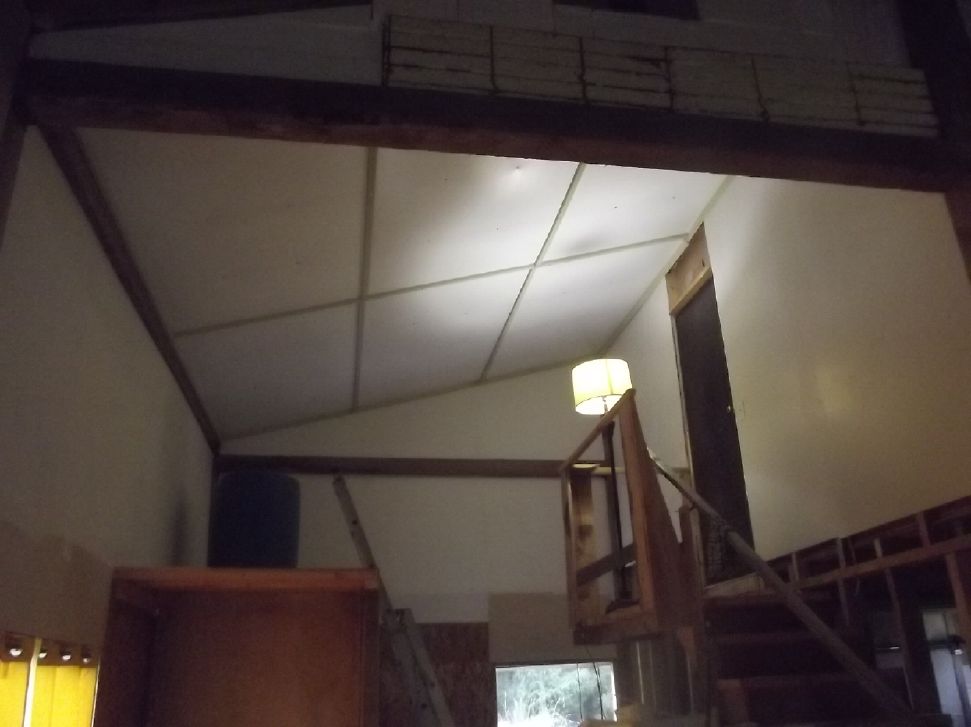
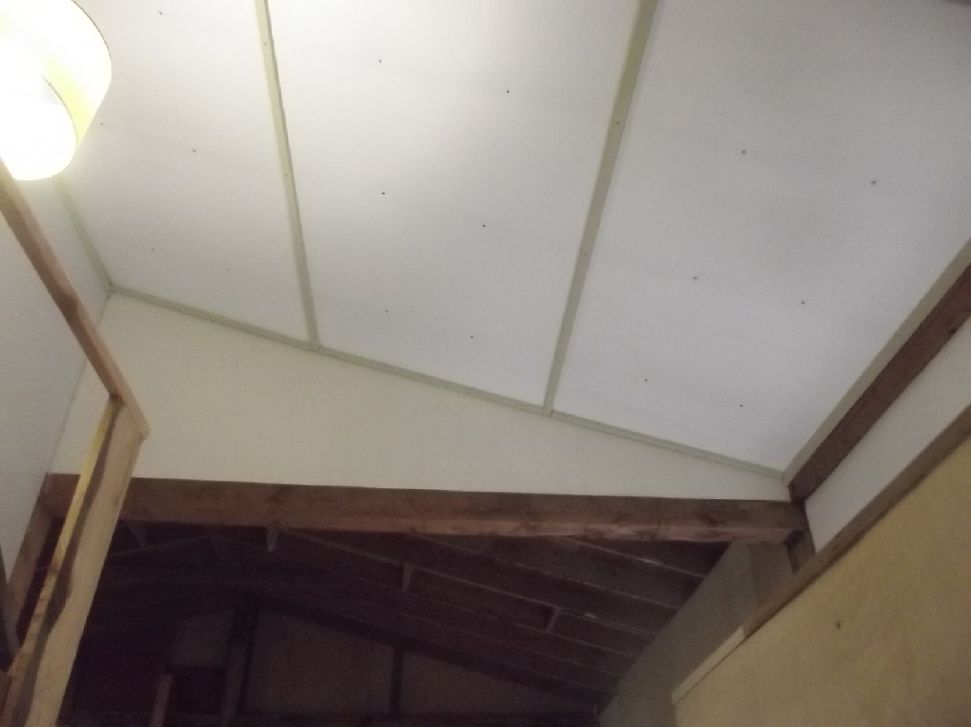
Electrosmog/Tinnitus
On a side note with sleeping in the cabin November
1st and then working out there most of the next day, by afternoon
my tinnitus was notably much reduced. I looked forward to it
perhaps almost disappearing (for the first time in 35 years) by
the next morning. But in the afternoon I had plugged in a DC to DC
power adapter for the hot wire cutter. It was under the
scaffolding maybe a dozen feet from my bed. 100 KHz electrosmog!
Instead of reduction that night, at 2:30 AM I woke up with my
tinnitus screaming. One. lousy. effing. power adapter! I had to do
stuff in the yard and in the house; I had to drive into town
(under the power lines). The ringing was never as quiet again, at
least in early November.
A youtube video explained that one should put a small
capacitor across diodes to damp electrical noise, which especially
occurs during reverse recovery time as the diode starts to
conduct. I'd never heard of this before and I bet those making AC
to DC and DC to DC converters haven't either. He had made a meter
with a probe that he could put near offending components that
turned the electrical noise into audio noise. There was a big
difference with the capacitor. I should have made a note of the
channel! As well as new stuff he had some ancient electronics - a
tube amp, a dual beam oscilloscope like I had drooled over in 1973
at Malaspina College... "Something...electronics"? Maybe I should
try to find it again ...and build the meter?
Haida Gwaii Gardening - Prep for
winter
 My large "Carpathian" English walnut
recovered and grew leaves after I put a huge plastic bag over it
to keep it warmer. In October I finally took the bag off. It
looked pretty good but lost the leaves in 2 or 3 weeks. It's
autumn anyway. I'll put the bag back on in the spring and hope it
lasts another summer.
My large "Carpathian" English walnut
recovered and grew leaves after I put a huge plastic bag over it
to keep it warmer. In October I finally took the bag off. It
looked pretty good but lost the leaves in 2 or 3 weeks. It's
autumn anyway. I'll put the bag back on in the spring and hope it
lasts another summer.
The little Black walnut was still bare, all summer.
I've kept watering it along with the Carpathian. I'll put its bag
back on in the spring, too, but my hopes aren't very high.
The corn I grew ran out by October. All that work for
a dozen(?) small cobs of corn! Is it worth it? Maybe I'll start it
earlier in the spring in individual pots and get it bigger before
I put it out in the box, like the ones I got from Dragonfly
Garden, which grew well. Ditto for squash, which was a total
wipeout this year except for a couple of zucchinis, and a cucumber
from a plant someone was giving away. Planted late, it didn't grow
very large. A mouse chewed on its second cucumber not long before
it got to where I would have picked it.
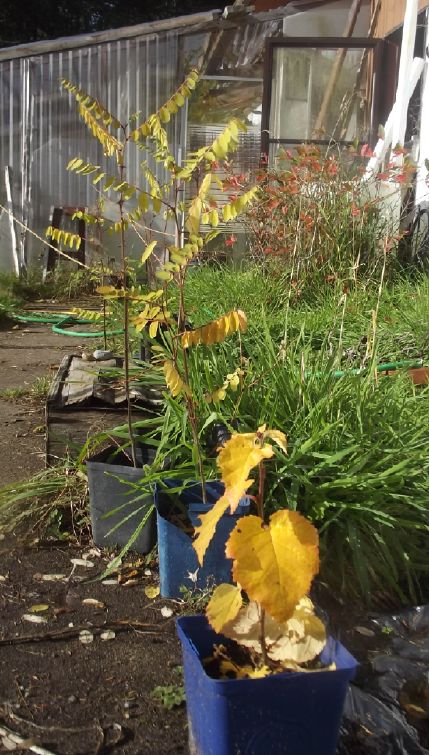 The trees I planted from seed had grown well over the summer. Just
one of the black locusts suddenly lost half its leaves very early.
I looked and found a two inch long grey-brown caterpillar the same
as the one that had finished off every remaining leaf on my first
walnut tree!
The trees I planted from seed had grown well over the summer. Just
one of the black locusts suddenly lost half its leaves very early.
I looked and found a two inch long grey-brown caterpillar the same
as the one that had finished off every remaining leaf on my first
walnut tree!
The three birch trees lost their yellow leaves first,
each one losing all of them in one day. (Not the same day for all
three.)
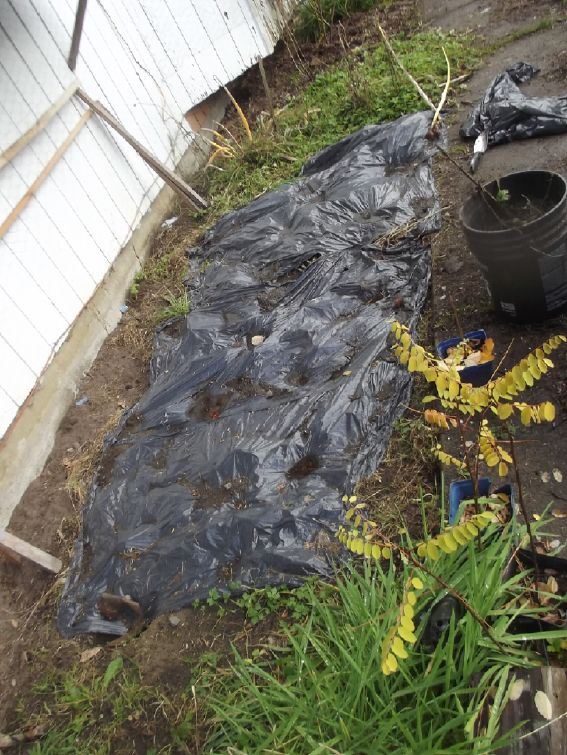 To try and kill weeds, I decided to put black plastic over patches
of ground. I've heard it works well because the black warms the
soil and causes the seeds to germinate, but then the plants die
because they con't get any light. First I spread out three black
plastic bags cut in half and it seemed good. Then the chickens
came in and started scratching up everything. In a few days the
plastic was all clumped up.
To try and kill weeds, I decided to put black plastic over patches
of ground. I've heard it works well because the black warms the
soil and causes the seeds to germinate, but then the plants die
because they con't get any light. First I spread out three black
plastic bags cut in half and it seemed good. Then the chickens
came in and started scratching up everything. In a few days the
plastic was all clumped up.
On the 25th I planted five four foot rows of garlic
for next year. (mainly 'red', a row and a half of 'elephant') In
addition to everything else I put down a thick mulch of eel grass
from the beach to insulate the ground from frost and to smother
starting-up weeds. Then, as I had started letting the chickens
into the south wall garden in the late afternoons (there being
little left for them to wreck), I threw a piece of fence wire over
the plot to keep them from digging it all up. They can dig, and
poop, all they like where nothing is planted.
Soon after this I had the thought that, because of
the fabulous success of my garden garlic patches (when so many
other crops are so disappointing), I'm probably planting and
eating too much of it. In times gone by never used to eat much or
any - a sprinkle of dried garlic flakes occasionally was just fine
and a bottle lasted for ages. Of course you don't smell garlic in
yourself. But if others do, being too polite to mention it,
they'll just draw away. Maybe I'll trade garlic for something
else. Or give some away. I've just planted for next year, but I
think I'll cut it back to a row or two after this. Maybe I can
grow some better onions in a bigger patch instead and not run out
of them half way through the winter?
My potatos, which I've said "grow like weeds around
here", were swallowed by weeds this year. The chickweed was
almighty. It covered everything. And the grass. And in the rare
places where the ground was bare the chickens scratched a few from
the surface and ate them. They seem to have developed a taste for
them. I've got so few I'll have to use the majority for seed for
next year.
Speaking of which, the five year old Auricanas were
still producing eggs quite well through the summer. At the end of
September they stopped abruptly and I've had none of their green
shelled eggs since. The younger hens, laying brown or pink eggs,
were still laying into November. But now they're all moulting, so
they probably won't be laying much more until early spring.
Here are a couple of gratuitous pics of my main
garden near the end of October.

South half.
The chickweed, the chickweed! Awrg!

The northwest part.
Hazelnuts on the left, a row of peas removed, water barrel, the
raspberry jungle on the right.
The 'everbearing' raspberries are still producing into November.
I think this is the only variety I'd
plant if there's a "next time". And one row is probably enough
for me. Who needs oodles and
oodles of berries in July and August and then none? I don't can
so I freeze them --and then
never get around to using them.
Self Pickled Cherry Tomatos
Tomatos cut in half,
set on dryer
rack
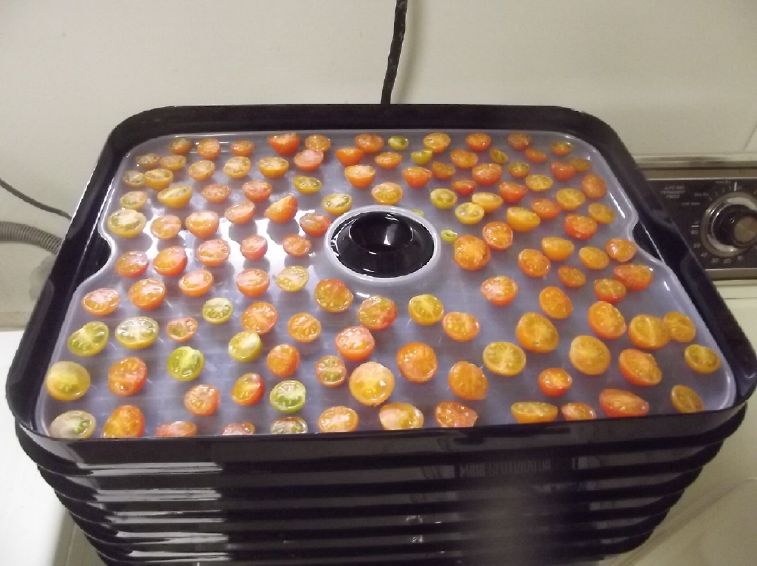 I got tons of cherry
tomatos. I gave some away, the chickens ate some, I ate some, but
there were still lots. I decided to dry some. I had bought a food
dryer last year. (Home Hardware ...150$?) I cut them in half, and
instead of drying them to a crisp, I dried them for 8 hours. That
left them a bit moist. The aim here was that as the water content
drops, the acidity in the tomatos becomes so high that they are
"self pickled" rather than dried. They should last for as long as
I want them, and still should be much more nutritious and "tomato
like" than dried food.
I got tons of cherry
tomatos. I gave some away, the chickens ate some, I ate some, but
there were still lots. I decided to dry some. I had bought a food
dryer last year. (Home Hardware ...150$?) I cut them in half, and
instead of drying them to a crisp, I dried them for 8 hours. That
left them a bit moist. The aim here was that as the water content
drops, the acidity in the tomatos becomes so high that they are
"self pickled" rather than dried. They should last for as long as
I want them, and still should be much more nutritious and "tomato
like" than dried food.
After 8 hours
drying

 I put three batches of
these "pickled" tomatos into one jar of less than a pint. They
certainly shrank a lot to all fit into it. The jar is over half
full of liquid. (So much for "dried"!) After several weeks at room
temperature there is no sign of mold, which quickly destroys the
untreated fruits.
I put three batches of
these "pickled" tomatos into one jar of less than a pint. They
certainly shrank a lot to all fit into it. The jar is over half
full of liquid. (So much for "dried"!) After several weeks at room
temperature there is no sign of mold, which quickly destroys the
untreated fruits.
So I tried a few on a cheese, beach lambs quarters
and pickled tomato sandwich. Notwithstanding the tomatos' acidity,
it was great! I'm sure they'll be delicious on burgers, pizza and
so on. Good "preserves" once the fresh ones are gone.
(The "lambs quarters" grow in summer on the sandy ocean beach just
above the regular high tide lines, where winter storms have washed
away other vegetation. The leaves look like lambs quarters leaves
and people call them "lambs quarters", but I don't expect they're
related.)
New Grid-Tied Solar Power System
[Oct. ?] I found an email from the electrical contractor from
early August - almost two months old, requesting a couple of
pieces of information including the BC Hydro approval number -
in the "spam" folder of my email. This is doubtless the reason I
haven't had any approvals to turn the breaker on yet. Yuk! Well,
I should have been inquiring sooner, I suppose. (There was also
a personal email from someone in the "spam". Apparently I must
check it occasionally.)
But the contractor relied that he had already got
the info and as far as he knew everything was done from their
end. He said he could look into it if I wanted. There's not much
more sun now until spring.
I finally e-mailed to BC Hydro on November 9th.
My (Old) Solar Power System(s)
(My solar panels recent images - TE News #200)
The Usual Daily/Monthly/Yearly
Log of Solar Power Generated [and grid power consumed]
Notes:
* All times are in PST: clock ~48 minutes ahead of local
sun time, never PDT which is an hour and 48 minutes ahead.
* Unapproved AC/Grid Tied systems have been removed.
* House panels include four old ones on the roof (upper - total
rating ~ 1000W), two 305W on the roof, three 305W on the south
wall below the roof, and one broken panel mounted verticly on the
porch railing (seems to still work but a lot of shade there).
* Cabin DC includes the three carport panels and the two on a pole
in the yard as well as the four on the cabin roof itself. All nine
are 305W.
* The wall, pole and porch panels are easily wiped off from the
ground if it snows.
* Km = Nissan Leaf electric car drove distance, then car was
charged. Car KWH does not add to or subtract from any other
readings.
Recent fotos of solar panels, TE News #200:
House System Panels: House roof, wall (9 solar panels) -
Porch (1 broken one - usually shady)
Cabin System Panels: Carport (3 - sunniest place on the
whole property) - Pole (2 - shadiest place) -Faraday Cabin (4 -
badly shaded in winter)
New Order of Daily Solar Readings (Beginning November 2024):
Date HouseDC, CabinDC => Total KWH Solar [Notable power Uses
(EV); Grid power meter@time] Sky/weather, notes...
September
30th 929.37, 686.45 => 2.14 [35Km; 31977@21:00]
October
1st missed (oops!) ...> 7.23
2nd 940.09, 690.19 => 7.23 (14.46) [32016@23:30]
3rd 942.24, 690.63 => 2.61 [32025@20:00]
4th missed...............> 3.92 [105Km]
5th 948.47, 692.24 => 3.92 (7.84) [32099@18:30]
6th 950.20, 693.19 => 2.68 [32123@22:00]
7th 963.90, 694.06 => 4.57 [32139@20:30]
8th
missed
=>
2.29
9th 965.53, 697.01 => 2.29 (4.58) [32201@18:30]
10th 970.05, 698.21 => 5.72 [32231@23:00]
11th 973.98, 698.60 => 4.32 [32250@??]
12th 979.46, 699.35 => 6.23 [32269@??]
13th 983.81, 699.69 => 4.71 [32285@20:00]
14th 986.09, 700.05 => 2.64 [32305@18:30]
15th 989.71, 700.40 => 3.98 [32322@22:00]
16th 993.22, 700.78 => 3.89 [32333@20:00]
17th 996.00, 702.94 => 4.94 [32372@?]
18th 998.22, 704.92 => 4.20 [32405@20:30]
19th 1000.81, 707.42 => 5.09 [324441@23:30]
20th 1003.96, 709.50 => 5.23 [32530@19:00]
21st 1004.63, 710.92 => 2.09 [55Km; 32506@21:00]
22d 1007.24, 712.27 => 3.96 [32530@19:00] -- Was not well
23d 1009.81, 713.95 => 4.25 [32550@18:30]
24th --- missed --- => 2.10
[---]
25th 1012.22, 715.74 => 2.10 (4.20) [32581@18:30]
26th 1016.84, 719.69 => 8.57 [32645@19:30]
27th 1019.49, 722.35 => 5.31 [32682@23:00]
28th 1019.82, 723.05 => 1.03 [32720@23:00] -- Well again
29th 1020.86, 724.60 => 2.74 [55Km; 32754@20:30]
--- ||| My Mother's 100th Birthday! |||
30th 1021.61, 725.61 => 1.76 [23779@18:30]
31st 1022.59, 727.31 => 2.68 [85Km; 32815@18:00]
November
1st 1023.74, 728.89 => [32845@20:00]
2d 1026.14, 730.80 => [32876@18:00]
3rd 1028.63, 732.87 => [32912@17:30]
4th 1029.22, 733.37 => [55Km; 32953@17:30]
5th 1030.02, 734.77 => [45Km; 33001@'24:30']
6th 1031.70, 736.08 => [33030@20:30]
7th 1034.62, 737.77 => [33074@'24:00']
8th 1034.79, 738.22 => [105Km; 33115@20:00]
9th 1036.89, 739.99 => [33153@'24:00']
10th 1038.19, 741.35 => [33193@17:00]
11th 1041.04, 743.45 => [50Km; 33235@19:00]
12th 1043.32, 745.17 => [55Km; 33278@20:30]
13th 1045.43, 746.59 => [33316@17:30]
Chart of daily KWH from solar panels. (Compare October 2025 with July 2025 &
August 2024.)
Days of
__ KWH
|
October
2025
|
September 2025
|
October 2024
(18 C's - Grid
Ties & DC)
|
0.xx
|
|
|
|
1.xx
|
2
|
1
|
1
|
2.xx
|
10
|
5
|
3
|
3.xx
|
5
|
4
|
3
|
4.xx
|
5
|
3
|
3
|
5.xx
|
5
|
2
|
4
|
6.xx
|
1
|
6
|
3
|
7.xx
|
2
|
3
|
5
|
8.xx
|
1
|
2
|
3
|
9.xx
|
|
1
|
|
10.xx
|
|
2
|
2
|
11.xx
|
|
|
3
|
12.xx
|
|
1
|
1
|
13.xx
|
|
|
|
Total KWH
for month
|
134.08
|
179.02 |
198.43
|
Km Driven
on Electricity
|
400.9 Km
@8.0 Km/KWh
50 KWh
|
(Lost owing to 12V
battery replacement)
|
925Km
~120KWH
|
Things Noted - October 2025
* In the cooler autumn weather I started using solar electric heat
in my (house) bedroom. After my usual two Saturday car trips and
using the 3.8 KW station after the first, I charged the Leaf again
Sunday from the solar, but there wasn't enough energy in the house
battery, then Monday. I got distracted Monday (weiner roast with
friends!) and left the charge on until the car was full - but the
house battery was quite low. Then it got cloudy. I was unable to
use the system for heat Monday and Tuesday nights. With the
shortening days and clouds there isn't enough power from nine
solar panels for both. When I finish insulating the cabin these
tasks can be better split between them. (An OLAHP heating system
in the cabin and using 1/2 the energy in the lightweight Sprint
car with the ultraefficient unipolar Electric Hubcap motor and
direct planetary gear to wheel drive would be tremendously
helpful! Dream on!)
* And while the nominal battery voltage is "36 volts", for home
uses with under 750 watts loads it's rarely below 38 volts. If I
put the new 325 amp-hour cells in the cabin, it'll be: (290 AH +
325 AH) * 38 V = 23370 watt-hours. That's about as much as the
Nissan Leaf, so if I charged it at the cabin from full batteries,
I wouldn't have to worry about draining them too far.
* On the morning of the 28th I looked and saw there was only 60
watts being made at the cabin. I thought five of the panels (on
one cable) must have come disconnected leaving only the four on
the cabin roof. Then I went to the house and it was only 50 watts!
In the afternoon when I looked again the cabin was up to just 80
watts. The day was just that dull!
* The Leaf seems to use substantially more energy to recharge than
the "kilometers per kilowatt-hour" + "kilometers driven" readings
on the dash indicate. I can only measure it when charging via
solar power. There's the inefficiency of the inverter when on
solar power to consider, but even so I don't think charging
lithium ion batteries is as efficient as is claimed.
Monthly Summaries: Solar Generated KWH [& Power
used from grid KWH]
As these tables are getting long, I'm not repeating the log of
monthly reports. The reports for the SIX full years (March 2019 to
February 2025) may be found in TE News #201, February 2025.
Note that in November 2024 I had to disconnect the "unapproved"
solar power systems from the power grid, and I have been running
them as two "off grid" 300 amp-hour, 36 volt, battery systems
since.
2024
Month: HouseAC + DC +Carport+Cabin[+DC] (from Aug 2024)
Oct KWH 78.48+ 7.29 + 64.39 + 7.52 + 40.75 =
198.43 [grid: 711; car: 120*]
Nov KWH 19.63+12.19+ 23.90 + 3.35 + 25.62
= 84.69 [grid: 900 (ACK!);car: 110*] Changed solar system to "off grid only" on 18th.
Now solar is charging
batteries only. Two 36 V DC systems: house, cabin, each 10
KWH, each 9 solar panels once wired.
Dec KWH 20.37 + 16.76 = 37.13 [grid: 1866 (using electric
heat - awg!); car: 120*]
2025
Jan KWH 35.02 + 26.30 = 61.32 [grid: 2136 (electric
heat OW!); car: 120*]
Feb KWH 55.43 + 39.00 = 94.43 [grid: 1937; car: 100*]
SIX full Years of
solar!
Mar KWH 115.13 + 87.41 = 202.54
[grid: 1860; car: 155* KWH]
Apr KWH 126.25 + 120.36 = 246.61 [grid: 1246; car: 100*]
May KWH 147.08 + 186.24 = 333.32 [grid: 1354; car: 150*]
Jun 145.58 + 170.97 = 316.55 [grid: 959; car: 130*]
July 156.48+ 86.78 = 243.26 [grid: 653; car 130]
Aug 118.56 + 48.50 = 167.06 [grid: 616; car 150]
Sept 115.15+ 63.87 = 179.02 [grid: 576; car: trip meter reading
lost with 12V battery replacement]
Oct 93.22 + 40.86 = 134.08 [grid: 868; car: 50]
* Car consumption comes from solar and or
grid: it does not add to other figures. (Just from grid from
Nov. 18th. 2024 except some direct solar charging summer 2025)
Annual Totals
1. March 2019-Feb. 2020: 2196.15 KWH Solar [used 7927
KWH from grid; EV use: -] 10, 11, 12 solar panels
2. March 2020-Feb. 2021: 2069.82 KWH Solar [used 11294 KWH from
grid; EV use: - (More electric heat - BR, Trailer & Perry's
RV)] 12 solar panels
3. March 2021-Feb. 2022: 2063.05 KWH Solar [used 10977 KWH from
grid; EV use ~~1485 KWH] 12 solar panels, 14 near end of year.
4a. March 2022-August 2022: in (the best) 6 months, about 2725 KWH
solar - more than in any previous entire year!
4. March2022-Feb. 2023: 3793.37 KWH Solar [used 12038 KWH from
grid; EV use: ~1583 KWH] 14, 15, 18 solar panels
5. March 2023-Feb. 2024: 3891.35 KWH Solar [used 7914 KWH from
power grid; EV use: ~1515 KWH] 18 solar panels
6. March 2024-Feb. 2025: 3428.88 KWH Solar [used 12773 KWH from
grid; EV used: ~1685 KWH]
Money Saved or Earned - @ 12¢ [All BC residential elec.
rate] ; @ 50¢ [2018 cost of diesel fuel to BC Hydro] ; @ 1$ per
KWH [actual total cost to BC Hydro in 2022 according to an
employee]; or maybe it's 62 ¢/KWH [according to BC Hydro at
Renewable Energy Symposium Sept. 2024]:
1. 263.42$ ; 1097.58$ ; 2196.15$
2. 248.38$ ; 1034.91$ ; 2069.82$
3. 247.57$ ; 1031.53$ ; 2063.05$
4. 455.20$ ; 1896.69$ ; 3793.37$
5. 466.96$ ; 1945.68$ ; 3891.35$
6. 411.47$ ; 1714.44$ ; 3428.88$
I had to disconnect the system from the grid in
November 2024. These two now independent installations (house,
cabin) will continue to run their 36 volt DC systems and I'll see
how I can most effectively utilize the available solar energy with
the limited available storage.
http://www.TurquoiseEnergy.com
Haida Gwaii, BC Canada




 At first I thought to use up my oldest AA cells, but it hardly
worked. I connected two 0.27 ohm resistors (0.56 ohms) to
alligator clip leeds and clipped them to my voltmeter probes. With
this 2 amp load these old cells (which are ten or more years old)
dropped to .2, .4 or .6 volts. They still run a clock or a
flashlight okay, but not the drill. Newer cells stayed above 1.1
volts. Having gone this far, I replaced the cells in the pack with
the better ones.
At first I thought to use up my oldest AA cells, but it hardly
worked. I connected two 0.27 ohm resistors (0.56 ohms) to
alligator clip leeds and clipped them to my voltmeter probes. With
this 2 amp load these old cells (which are ten or more years old)
dropped to .2, .4 or .6 volts. They still run a clock or a
flashlight okay, but not the drill. Newer cells stayed above 1.1
volts. Having gone this far, I replaced the cells in the pack with
the better ones. It starts up sluggishly and one would think it would have no
torque to speak of, but it worked fine when I went to do some
construction with it, drilling pilot holes and putting in 1.5 inch
screws, and it worked as long as I needed it for. It just screwed
slower when it got tough. (It probably would have stalled on 3
inch screws into lumber.) I first used it "for real" when the
Li-ion drill (too frequently) died during the job in the cabin, so
I didn't immediately have to run back to the house and change
batteries.
It starts up sluggishly and one would think it would have no
torque to speak of, but it worked fine when I went to do some
construction with it, drilling pilot holes and putting in 1.5 inch
screws, and it worked as long as I needed it for. It just screwed
slower when it got tough. (It probably would have stalled on 3
inch screws into lumber.) I first used it "for real" when the
Li-ion drill (too frequently) died during the job in the cabin, so
I didn't immediately have to run back to the house and change
batteries.

 Then I thought of putting the whole
piece of plastic in the kitchen oven. After all, it was still so
stiff in its "melted" state that it didn't even seem to sag. I put
it in the oven on 400 degrees F for 30 minutes. It went from white
to transparent. It was still so stiff I needed assistance to punch
the brass tube through. I used the hydraulic press.
Then I thought of putting the whole
piece of plastic in the kitchen oven. After all, it was still so
stiff in its "melted" state that it didn't even seem to sag. I put
it in the oven on 400 degrees F for 30 minutes. It went from white
to transparent. It was still so stiff I needed assistance to punch
the brass tube through. I used the hydraulic press. The piece was pretty ugly and I tried again, but I guess it had
cooled more and although it still went through, there was no piece
inside the tube at all. It had just squished around it.
The piece was pretty ugly and I tried again, but I guess it had
cooled more and although it still went through, there was no piece
inside the tube at all. It had just squished around it. Not quite satisfied with the fit I put in a couple of UHMW flakes
and bent a piece of alume to the general curve, heated it up, and
melted the flakes into the join area. They filled a tiny gap and
it seemed pretty good.
Not quite satisfied with the fit I put in a couple of UHMW flakes
and bent a piece of alume to the general curve, heated it up, and
melted the flakes into the join area. They filled a tiny gap and
it seemed pretty good. [25th]
I got out some grey clay ["Laguna B-mix, cone 5"] and shaped such
insulators along with some spacer washers, and let them dry.
[25th]
I got out some grey clay ["Laguna B-mix, cone 5"] and shaped such
insulators along with some spacer washers, and let them dry. [27th] I unwrapped the heating wires and assembled
it the new way. At a place where a join was needed, the wires were
two inches to short to reach each other. I moved the end screw
down two inches, gaining four inches of wire so that there was an
overlap instead and I could twist them together.
[27th] I unwrapped the heating wires and assembled
it the new way. At a place where a join was needed, the wires were
two inches to short to reach each other. I moved the end screw
down two inches, gaining four inches of wire so that there was an
overlap instead and I could twist them together. Except for being nearly finished at that point, why was I doing
this then? Using the screws would be actually superior as well as
easier to make, eliminating the pottery. Just like I had it in the
first place, with an extra twist at each screw. I took it apart
and put it back together that way. (Hmm... the screws where the
clips connect will still get hot!)
Except for being nearly finished at that point, why was I doing
this then? Using the screws would be actually superior as well as
easier to make, eliminating the pottery. Just like I had it in the
first place, with an extra twist at each screw. I took it apart
and put it back together that way. (Hmm... the screws where the
clips connect will still get hot!) To do a lowered ceiling in the East half when the West half is
vaulted ceiling, I needed to put up a "gable end" wall at the
center. The ceiling panels and the 8 foot (east-west) trim pieces
stuck past the critical point a few inches, and I wasn't sure what
to do. I put up the 4 foot (north-south) end trim about where I
thought it should go anyway, and that made the way clear: I could
cut the ceiling panels along the edge of the trim with a knife,
and then trim the offending E-W trim boards even with all that. I
had ordered an "oscillating multi-tool" from China which would
have been great - and safe - to cut the ends of the boards, but it
hadn't come yet so I used the circular skill saw as carefully as I
could. I don't like holding a saw that can kick right over my head
to do a fine cut, but I couldn't think of anything else that was
practical.
To do a lowered ceiling in the East half when the West half is
vaulted ceiling, I needed to put up a "gable end" wall at the
center. The ceiling panels and the 8 foot (east-west) trim pieces
stuck past the critical point a few inches, and I wasn't sure what
to do. I put up the 4 foot (north-south) end trim about where I
thought it should go anyway, and that made the way clear: I could
cut the ceiling panels along the edge of the trim with a knife,
and then trim the offending E-W trim boards even with all that. I
had ordered an "oscillating multi-tool" from China which would
have been great - and safe - to cut the ends of the boards, but it
hadn't come yet so I used the circular skill saw as carefully as I
could. I don't like holding a saw that can kick right over my head
to do a fine cut, but I couldn't think of anything else that was
practical. After that I started in on framing the triangular space between
the 6 by 6 beams, roof angle and lower support. Then I cut 1/4
inch plywood paneling to fit.
After that I started in on framing the triangular space between
the 6 by 6 beams, roof angle and lower support. Then I cut 1/4
inch plywood paneling to fit. [November
2nd] The interior "gables" needed insulation and I got started on
that, including at the end of the bedroom. With no roof insulation
yet, doing that bit of wall just might make it just a touch easier
to heat the bedroom, too. [Seemed to help.] I also tacked up some
2x8 foam panels between the studs on the other bedroom interior
wall. That too should help until the whole structure is insulated.
(One thickness of 1/2 inch gyproc isn't noted as being wonderful
insulation!)
[November
2nd] The interior "gables" needed insulation and I got started on
that, including at the end of the bedroom. With no roof insulation
yet, doing that bit of wall just might make it just a touch easier
to heat the bedroom, too. [Seemed to help.] I also tacked up some
2x8 foam panels between the studs on the other bedroom interior
wall. That too should help until the whole structure is insulated.
(One thickness of 1/2 inch gyproc isn't noted as being wonderful
insulation!) [Nov.
3rd] I did more "gable end insulating" and felt I was ready to put
the plywood up. Again I used scraps of styrene foam (2+ inches
thick - R10+), plus a couple of polyurethane(?) foam pieces from a
freezer (R6 per inch: R12+).
[Nov.
3rd] I did more "gable end insulating" and felt I was ready to put
the plywood up. Again I used scraps of styrene foam (2+ inches
thick - R10+), plus a couple of polyurethane(?) foam pieces from a
freezer (R6 per inch: R12+).

 My large "Carpathian" English walnut
recovered and grew leaves after I put a huge plastic bag over it
to keep it warmer. In October I finally took the bag off. It
looked pretty good but lost the leaves in 2 or 3 weeks. It's
autumn anyway. I'll put the bag back on in the spring and hope it
lasts another summer.
My large "Carpathian" English walnut
recovered and grew leaves after I put a huge plastic bag over it
to keep it warmer. In October I finally took the bag off. It
looked pretty good but lost the leaves in 2 or 3 weeks. It's
autumn anyway. I'll put the bag back on in the spring and hope it
lasts another summer. The trees I planted from seed had grown well over the summer. Just
one of the black locusts suddenly lost half its leaves very early.
I looked and found a two inch long grey-brown caterpillar the same
as the one that had finished off every remaining leaf on my first
walnut tree!
The trees I planted from seed had grown well over the summer. Just
one of the black locusts suddenly lost half its leaves very early.
I looked and found a two inch long grey-brown caterpillar the same
as the one that had finished off every remaining leaf on my first
walnut tree! To try and kill weeds, I decided to put black plastic over patches
of ground. I've heard it works well because the black warms the
soil and causes the seeds to germinate, but then the plants die
because they con't get any light. First I spread out three black
plastic bags cut in half and it seemed good. Then the chickens
came in and started scratching up everything. In a few days the
plastic was all clumped up.
To try and kill weeds, I decided to put black plastic over patches
of ground. I've heard it works well because the black warms the
soil and causes the seeds to germinate, but then the plants die
because they con't get any light. First I spread out three black
plastic bags cut in half and it seemed good. Then the chickens
came in and started scratching up everything. In a few days the
plastic was all clumped up.

 I got tons of cherry
tomatos. I gave some away, the chickens ate some, I ate some, but
there were still lots. I decided to dry some. I had bought a food
dryer last year. (Home Hardware ...150$?) I cut them in half, and
instead of drying them to a crisp, I dried them for 8 hours. That
left them a bit moist. The aim here was that as the water content
drops, the acidity in the tomatos becomes so high that they are
"self pickled" rather than dried. They should last for as long as
I want them, and still should be much more nutritious and "tomato
like" than dried food.
I got tons of cherry
tomatos. I gave some away, the chickens ate some, I ate some, but
there were still lots. I decided to dry some. I had bought a food
dryer last year. (Home Hardware ...150$?) I cut them in half, and
instead of drying them to a crisp, I dried them for 8 hours. That
left them a bit moist. The aim here was that as the water content
drops, the acidity in the tomatos becomes so high that they are
"self pickled" rather than dried. They should last for as long as
I want them, and still should be much more nutritious and "tomato
like" than dried food.
 I put three batches of
these "pickled" tomatos into one jar of less than a pint. They
certainly shrank a lot to all fit into it. The jar is over half
full of liquid. (So much for "dried"!) After several weeks at room
temperature there is no sign of mold, which quickly destroys the
untreated fruits.
I put three batches of
these "pickled" tomatos into one jar of less than a pint. They
certainly shrank a lot to all fit into it. The jar is over half
full of liquid. (So much for "dried"!) After several weeks at room
temperature there is no sign of mold, which quickly destroys the
untreated fruits.